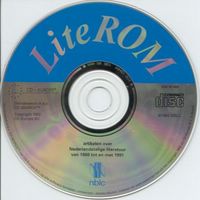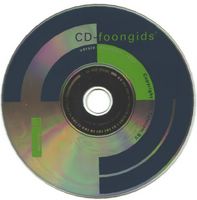While videotex and ASCII databases were fighting for a place in the Dutch new media scene, Philips and Sony worked on a new information carrier which could influenece the online industry. Riding on the success of the audio compact disc, both companies applied the technology to data. The data disc was born.

First commecial disc (compliments of Mr Ulrich Frank)
In 1984 Philips started to inform publishing organisations. Workshops were held and visits to Eindhoven arranged. Especially the scientific publishers like Elsevier Science saw a future in this disc. It was like a mega book as far as its distribution, marketing and pricing was concerned. One of the first pilot discs made by Philips was a disc with an American database Medline.
In 1985 the data disc or CD-ROM got an impulse from First Micrsoft Conference on CD-ROM. The conference yielded two book publications and a CD-ROM. One of the publications The New Papyrus showed the new opportunities. The CD-ROM Microsoft Bookshelf contained a series of reference works. (Every delegate to the conference received a copy, regardless whether they had a CD-ROM player; in most cases the silver disc was just a high tech beer mat).
The Dutch publishers with text databases started immediately with trials. Samsom Uitegverij produced the AROB disc Fiscus 84. VNU New Media produced two trial discs with articles and illustrations of the Great Spectrum Encyclopedia. Kluwer produced a disc with three databases: a legal database, a lexicographical database and a dentistry database.

First edition of LiteRom (collection Jak Boumans)
By 1987 commercialisation of Dutch CD-ROM titles started. CAT Benelux produced the PharmaRom with the search software Freebase. MID produced the legal database for Kluwer Datalex and Samsom Veldkamp had a selection of publications. And more titles followed. The Royal Tropical Institute had disc with Tropag & Rural databases. Nijgh Periodicals made a pilot of its Handbook for Press and Publicity. Van Dale Lexicography published Lexitron, the Contemporary Dictionary of the Dutch Language with additions from the Great Spectrum Encyclopedia (price 1750 Dutch guilders; 825 euro). By 1992 LiteRom, a disc with 43 000 reviews of literary books, was presented by the famous Dutch author W.F. Hermans in the Royal Library. And the Volkskrant, a Dutch national newspaper, started to store its archive on CD-ROM.
The scientific publishers preferred CD-ROM above online. The marketing of the discs was easier and the margin on the product was higher. Professional publisher Kluwer Datalex started to make a move from online to CD-ROM. And by 1992 they were so far that the basis of a subscription was a periodical CD-ROM with online updates. Samsom loved the silver carrier as it would not have to start up a hosting service again.

CD-Foongids (collection Jak Boumans)
A real conflict between online and offline arose with the PTT telephone directory. In 1989 a consortium of companies (Philips, SDU and MID) presented a business plan for a telephone directory to PTT Telecom; the plan included even a title suggestion cd-Foongids, a name later on used by PTT Telecom without compensation). But the plan disappeared as PTT Telecom saw the disc as a competitor of the paid directory on the Videotex Nederland Network. Eventually in 1991 PTT Telecom published its first CD-ROM with Freebase software. The price was 1000 Dutch guilders (450 euro). In 1996 the professional edition got a companion publication for consumers for 59 Dutch guilders (27,50 euro).
CD-ROM started to loose its importance from 1995 onwards, when Internet had made its start. By 1997 the telephone directory also appeared on Internet.

No comments:
Post a Comment